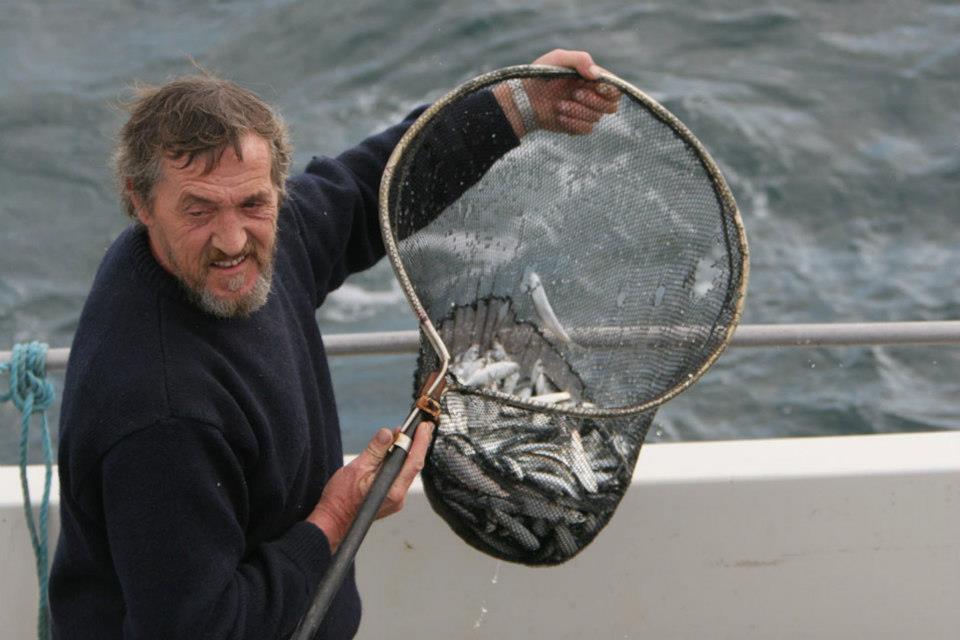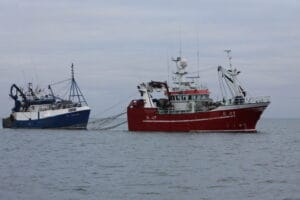This article was originally posted to the Cork Whale Watch Skippers Log by Colin Barnes, a long time commercial fisherman and one of Ireland’s most experienced and well respected whale watching operators in January 2014

Last January I wrote to Minister for Agriculture, Marine and Food, Simon Coveney, TD highlighting the problem of unsustainable inshore trawling for sprat off the Irish south west coast.
There is currently no quota on sprat in Irish waters, and never has been, so once trawlers have caught their quota of more commercial species like herring they are free to move inshore to catch as many sprat as they can physically land. This is patently an unsustainable way of fishing, and has a knock on detrimental impact on the entire marine ecosystem.

I have personally seen sprat stocks off West Cork decimated by this practice over the last few years, and if this sort of unregulated fishing is allowed to continue then I believe that the collapse of the Irish sprat stock is imminent. That’s bad enough… but the big picture consequences of this short sighted greed is much worse.
Sprat are a vital component in the coastal marine food chain — especially so since fishing pressure had reduced herring stocks in these waters to dangerously low levels. Herring is currently in a state of recovery, thanks to strong management and effective policing. Sprat are afforded no such protection despite the fact that they are a vital food source for many of the larger fish in our oceans, seabirds and of course for the whales and dolphins that visit our coasts for that very reason.
To date, other than a cursory acknowledgement of my original letter, I have had no response from the Minister on this issue. To move the debate forward I’ve drafted a follow up that I’m posting here as an open letter (copied to the Minister). Please take a few minutes to read this, and let us know what you think in the comments below, or visit the Cork Whale Watch Facebook page and leave your comments there.
Your comments, on either side of the issue, offer invaluable feedback that will help guide us as we move forward.
Mr Simon Coveney, TD
Minister for Agriculture, Marine & Food
Department of Agriculture, Marine & Food
Agriculture House
Kildare Street
Dublin 221 January 2014
Re. Decimation of Irish Sprat Stocks
Dear Sir,
I wrote to your office, in January 2013 expressing grave concern about the sprat fishing industry in the Irish south west. To update you on this situation, I can tell you based on my observations as a former commercial fisherman with 30 years of experience that the stocks that survived last year’s fishery have all but been wiped out by the persistent attention of mid-water trawlers. Only scraps remain of this season’s sprat shoals.
If this fishery is allowed to continue unregulated and uncontrolled, as it is at present, there is a real danger sprat stocks will become rare or even extinct. Similar fishing pressure was directed at the herring stock that gathered and spawned in the Stags/Toe Head area of West Cork. This stock was exploited sustainably for hundreds of years with gill nets, both drifted and anchored. Just a couple of decades of mid-water trawling has totally eradicated this stock, hounded to the last shoal and extinction. A huge amount of sprat that came into the harbour area of Glandore and Union Hall, West Cork every winter has suffered in the same way, fished to extinction. This stock had always existed as far back in time as anyone could remember.
One cannot overstate the importance of sprat as a forage species. They are a vital food supply for all commercial fish species taken by the fishing industry. In particular, all members of the cod family feed on sprat throughout their lives; from tiny size up to huge adults. Furthermore, sprats are a local species and do not roam offshore like their larger cousin, the herring. The fact that they all aggregate, in all age classes, in inshore waters, makes them extremely vulnerable to concentrated fishing effort. They remain in Irish waters and are not pursued by foreign vessels. They are truly a vital link in the marine food chain, performing the miracle of turning tiny plankton into rich, oily fish proteins. They are above all, vital prey items, not just for fish, but all seabirds and marine mammals, right up to the humpback and fin whales that return each year to our inshore waters.
Historically, sprats were not exploited in Irish waters, unlike the UK and Europe, where they were caught in gill nets for hundreds of years, in the same manner as herrings. Nowadays, they are fished everywhere by mid-water trawls. While both the UK and Europe have quotas placed on sprats, Ireland has no such arrangement. Presumably, they are considered to be unimportant, not worthy of protection, based on their monetary value.
Mid-water trawling was developed first by Germany in the 1950s, and had a devastating effect on North Sea herring, when it was discovered that immature herring formed enormous shoals off the German coast, and could be caught in enormous quantities by towing a large trawl between two boats. It was the beginning of industrial fishing, a dubious practice, carried out all over the planet, ever since. Mid-water trawling developed in Ireland at the start of the 1970s, and now, supported by sophisticated electronics, is a deadly effective method of catching shoaling pelagic fish. In the 1970’s and 1980’s sprats were detected by echo sounders, such that the boats would have to pass right over the shoals to see them. Inevitably, there were always some in tight or awkward places that were over-looked, and would get to spawn and disperse, thus perpetuating the species.
The danger now is that this situation has all changed. The mid- water trawlers now carry super-sensitive sonar that detects all shoals for a considerable distance around the vessel, so that none go undetected. Every shoal that gathered up this season was methodically swept up before any spawning took place. This is surely an example of crass, short-sighted fishery management on a grand scale. Allowing just a handful of trawlers plunder this vital biomass for a meagre €100 euro per ton, makes neither economic nor ecological sense. It is a curious fact that some of the largest and most powerful of trawlers are busy landing the smallest fish that can be legally taken from Irish waters. Hardly any of these fish are marketed or eaten in Ireland, but sold dirt cheap, mostly to eastern European countries.
This fishery should be terminated forthwith before there is a major collapse in our marine ecology, which already suffers from dwindling fish stocks. As a local stakeholder now involved in marine eco-tourism since 2000, I request that this matter be given more serious consideration, and at the very least that the sprat fishery be subject to a quota system which reflects their importance for a range of fish, bird and mammal species.
Yours faithfully,
Colin Barnes
Proprietor, Cork Whale Watch
